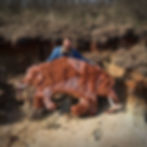When Fiction Becomes Fact: ART TALK with Joshua Goode, American Artist & Professor of Arts
- Bianca Vinther
- Feb 25, 2022
- 4 min read
On Tuesday, 15 February 2022, I had an exciting and funny conversation with Joshua Goode, an American artist who teaches fine arts at Tarrant County College in Forth Worth, Texas (USA), manages the college's art gallery, The Carillon, and is also in charge of the college's artist residency programme.
Check out this episode of THE POINTLESS ARTIST PODCAST here.
As food for your thoughts and inspiration in your creative process, I've included below an overview of Joshua’s mind-blowing work as an artist and a summary of my conversation with him.

How many of the Indiana Jones movies have you seen? And what struck you most about these films? If you ask me, I was struck by the unique blend of reality and fiction. It fascinates me, each time I watch these movies, to see the power of fantasy and myth.
Joshua Goode has been connected to Spielberg’s Indy many times before (he loves the character and movies by the way, so he’s always flattered by the comparison). He has often been referred to as “Indiana Jones of Art”. You shouldn’t wonder why.
Joshua’s art is a blend of historical facts, archaeology, and personal mythology. His body of work straddles the divide between facts and fiction but it’s more than just facts and fiction altogether. His works form a distinctive and complex “Imaginarium” of shapes and symbols that combine reality and personal phantasy in a perpetual dialogue.

He catalyses disparate elements and narratives into often humorous objects. Memories of Native American ceremonies and a trauma caused by his sister’s degenerative disease (which, for many years, forced her closest relatives to constantly prepare for an imminent death) are being processed and alchemically transformed into hybrids that connect to his personal experiences and challenge scientific facts, manipulation and misinterpretation of the truth, and ultimately our perception of reality.
As well as personal archaeology, there is a constant attempt to expose the power of manipulation through images and objects, and the fundamental importance of critical thinking across cultures.
While I was never an archaeologist myself, I worked with archaeological material for many years when studying Egyptology in Cairo and writing my PhD in Egyptology and Coptology in Germany. I had the privilege of meeting highly regarded archaeologists like Jean-Philippe Lauer, Mark Lehner, Peter Grossmann, and Zahi Hawass, and experiencing what archaeological excavation and discovery are like first-hand. I, therefore, completely understand Joshua's interest in archaeology and his passion for archaeological discoveries, which becomes so contagious through his art.
In his work, the confines between art and archaeology are superfluous. His wit and sarcasm blow our mental grids apart. By doing so, he removes all boundaries. Blurring reality and fiction opens the door to infinite possibilities. Moreover, it gives us the chance to create new relationships between what is and what could be, as well as between singularity, unicity and collective vision.
Joshua knows how to use and reflect on the possibilities of fiction as both an instrument for understanding his own trauma and a tool for exposing the danger of manipulation through artifacts. Paradoxically though, fiction can make people see the truth. See beyond confines and beyond the big stories that, as the British artist Lucianna Whittle says, “own us” way too often.
While convincing and humorous, his works make identifying where reality ends and fiction begins difficult and, at times, almost impossible. But Joshua doesn't mock us. His works are not treacherous because he reveals each time the subtle sutures that tie facts to fiction.

I love the fact that his works are so utterly unconventional. I invite you to explore how he combines forms and symbols from different sources, contexts and periods, and the way in which he suspends them outside spacial and chronological conventions. Beyond reality, beyond our common understanding of past and present, beyond the limits of the original source materials.
Joshua gives us a story of an "expanded" reality, which continues to grow with every interpretation.
In this podcast episode, we spoke about his motivation as an artist, the red-thread of his work, the way he sees, and his creative process. We also spoke about how he shares his work with others, the process of interpretation of the objects he creates, and the intricacies of producing a story and of conveying a personal narrative to others.
In this art talk, Joshua reveals his secret to transforming everyday objects into meaningful ones that others can connect with. He also discusses inspiration and artist block, which are at the heart of The Pointless Artist Blog, and shares what he finds most important in life.
I wholeheartedly invite you to listen to our art talk on my blog > Podcast > Art Talks, Anchor.fm, or Spotify > The Pointless Artist's ART TALKS.
Via The Pointless Artist Blog & Podcast, I support the creative energy of life and the artists who contribute to transforming this world into a freer, kinder, more inclusive, caring, transparent, and compassionate place to live. I firmly believe in the passion for art, the importance of sharing knowledge and experiences, and the power of personal stories to bring us together.

If you’ve got something to add, please comment on this blog post below, drop me an e-mail, or pm me on Instagram @the_pointless_artist. I'd love to hear from you!
To stay tuned and never miss a blog post, sign up for The Pointless Artist’s email list below.
Recognise your pointlessness and keep creating!
From Germany with love,
Bianca Vinther